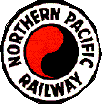 |
CABOOSE |  |

A caboose is a manned rail transport vehicle coupled at the end of a freight train. Although cabooses were once used on nearly every freight train in North America, their use has declined and they are seldom seen on trains, except on locals and smaller railroads.The caboose provided the train crew with a shelter at the rear of the train. They could exit the train for switching or to protect the rear of the train when stopped. They also looked out windows to inspect the train for problems such as shifting loads, broken or dragging equipment, and overheated journals (hot boxes). The conductor kept records and handled business from a table or desk in the caboose. For longer trips the caboose provided minimal living quarters, and was very frequently personalized and decorated with pictures and posters.
Coal or wood was originally used to fire a cast iron stove for heat and cooking, later giving way to a kerosene heater. Now rare, the old stoves can be identified by several essential features. They were without legs, bolted directly to the floor, and featured a lip on the top surface to keep pans and coffee pots from sliding off. They also had a double-latching door, to prevent accidental discharge of hot coals due to the rocking motion of the caboose.
Early cabooses were nothing more than flat cars with small cabins erected on them, or modified box cars. The standard form of the American caboose had a platform at either end with curved grab rails to facilitate train crew members' ascent onto a moving train. A caboose was fitted with red lights called markers to enable the rear of the train to be seen at night. This has led to the phrase bringing up the markers to describe the last car on a train (these lights were officially what made a train a "train").
Originally lit with oil lamps, with the advent of electricity, later caboose versions incorporated an electrical generator driven by belts coupled to one of the axles, which charged a lead-acid storage battery when the train was in motion.
Cabooses are non-revenue equipment and were often improvised or retained well beyond the normal lifetime of a freight car. Tradition on many lines held that the caboose should be painted a bright red, though on many lines it eventually became the practice to paint them in the same corporate colors as locomotives. The Kansas City Southern did something unique: They left their cabooses unpainted, but ordered them with a stainless-steel car body. These were the exception to the rule of painting cabooses.
The most common caboose form in American railroad practice has a small windowed projection on the roof, called the cupola. The crew sat in elevated seats in order to inspect the train from this perch.
Joe's Caboose has the table, bunk bed and a cast iron stove. This car was built in 1913. Not sure how Joe came up with the number 572 as that is not in found in the numbering system the NP used. The outside pictures were taken in the 1940's while the inside we taken in 2005.
Updated 19 Sept 2008